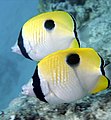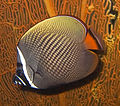Chaetodon
| Chaetodon | ||||||||||||
|---|---|---|---|---|---|---|---|---|---|---|---|---|

Chaetodon capistratus , the type species of the genus Chaetodon . |
||||||||||||
| Systematics | ||||||||||||
|
||||||||||||
| Scientific name | ||||||||||||
| Chaetodon | ||||||||||||
| Linnaeus , 1758 |
Chaetodon is the largest (most species-rich) genus of butterfly fish (Chaetodon), a family of conspicuous and mostly very colorful tropical marine fish. Chaetodon species live mainly in coral reefs of the tropical Indo-Pacific , the Red Sea and the tropical, western Atlantic . But they also occur, far less species-rich, north and south of the coral belt and in the rocky reefs of the tropical eastern Atlantic. The majority of the species live in shallow water, some still at depths of 30 to 60 meters and very few occur below that.
features
Chaetodon species have a high-backed, laterally strongly flattened body and, depending on the species, reach a body length of twelve to thirty centimeters. Their eyes are often camouflaged by a dark streak. Instead, in some species there is a noticeable eye spot in the back of the dorsal fin or on the caudal fin stalk. In most species, the sides of the body are drawn by a vertical, horizontal or diagonal pattern of stripes or dots. The unpaired fins are usually of a different color. The color and pattern are so characteristic that they can be used to distinguish almost all species. Young fish often deviate from the color of the adult fish and are difficult to identify, since the juvenile forms are little researched and insufficiently known.
Way of life
Most Chaetodon species live in pairs, some in small or larger groups. In the reef they are almost constantly looking for food. They are dependent on a habitat rich in hiding and seek shelters when threatened by predators and at night. Are the hiding places z. If, for example, the death of hard corals is less, the population density of the Chaetodon species also decreases.
nutrition

In terms of nutrition, a distinction can be made between corallivorous species, which are mostly food specialists and only feed on the polyps of stone or octocorals , and omnivorous species. The latter have a wide range of food and eat algae, various sessile animals such as sea squirts and sponges , and zooplankton , or act as spawning predators and eat the eggs of substrate spawners , such as those of damselfish . The corallivorous species are mostly specialized in certain species, C. trifascialis z. B. on table-shaped growing acropores . They reproduce rapidly when their preferred food coral forms dense populations that prevent other coral species from growing. By eating, the growth rate of the feed coral is reduced and the less dominant species are indirectly promoted. The corallivorous butterfly fish promote the biodiversity of the reefs. Investigations of the stomach contents of Chaetodon species caught near Okinawa showed that C. baronessa , C. bennetti , C. plebeius , C. trifascialis , C. trifasciatus and C. unimaculatus only eat stony coral polyps. In C. kleinii and C. melannotus the diet consisted of 30 to 50% soft coral fragments. C. auripes , C. lunula , C. rafflesii and C. ulietensis ate sea anemones . Their share of the diet was 67 to 84%. C. lineolatus almost exclusively eats sea anemones.
Reproduction
Chaetodon species do not care for the brood, but are free spawners who usually release their gametes in the evening at dusk. In Klein's butterfly fish ( Chaetodon kleinii ), in which the spawning process was observed in the aquarium, the pair slowly swims at an angle of 45 ° to the water surface, stops 10 centimeters below, suddenly releases eggs and sperm and quickly disappears towards the bottom of the water. Some species hybridize with one another, since spawning of different species at the same time is common. The hybrids are always sterile.
Systematics
A total of almost 90 species have been described. The genus can be divided into four main clades and is divided into a number of sub-genera, in which species that are similar in color, morphology and meristic values are grouped together. Very similar sister species or swarms of species can often be recognized that have arisen from a predecessor species through isolation . Sister group of Chaetodon is the genus Prognathodes . Together with this and the sail butterfly fish ( Parachaetodon ocellatus ) Chaetodon forms a clade, which is the sister group of the pennant and tweezer fish . The relationships are shown in the following cladogram :
| Butterfly fish |
|
||||||||||||||||||||||||||||||||||||||||||||||||||||||||||||||||||||||||||||||||||||||||||||||||
|
|
Subgenera and species
Subgenus Chaetodon Linnaeus, 1758, not monophyletic , mainly in the tropical Atlantic, mostly striated, all species under 20 cm in length, feed on invertebrates and algae.
Four-eyed butterflyfish
( C. capistratus )East Pacific butterflyfish ( C. humeralis )
Marley's butterflyfish ( C. marleyi )
Northern butterflyfish
( C. ocellatus )Striped Butterflyfish
( C. striatus )
- Hoefers butterflyfish ( C. hoefleri )
- Ghana butterflyfish ( C. robustus )
Subgenus Citaroedus Kaup, 1860, Indo-Pacific, high-backed, juvenile fish have an almost round body shape, snout short, mouth beak-like and strong, feed almost exclusively on coral polyps, occasionally also on algae.
Meyer's butterflyfish
( C. meyeri )Orange-striped butterflyfish
( C. ornatissimus )Pearl butterflyfish
( C. reticulatus )
Subgenus Corallochaetodon Burgess, 1978, Indo-Pacific, oval, almost round body shape, snout barely protruding , feed almost exclusively on coral polyps.
Red Sea Ribbed Butterflyfish
( C. austriacus )Pacific rib butterflyfish
( C. lunulatus )Arabian rib butterflyfish ( C. melapterus )
Indian rib butterflyfish
( C. trifasciatus )
Subgenus Discochaetodon Nalbant, 1971, Australia, Western Pacific, snout short, head profile round, feed mainly on coral polyps, as well as other invertebrates and algae.
Golden stripe butterflyfish ( C. aureofasciatus )
Eight- banded butterflyfish
( C. octofasciatus )Rainford's butterflyfish ( C. rainfordi )
Three-band butterflyfish
( C. tricinctus )
Subgenus Exornator Burgess, 1978 (including subgenus Heterochaetodon Mauge & Bauchot, 1984), Indo-Pacific and Atlantic, trunk relatively elongated, sides of the body with dark points, snout extended. Adult animals live in pairs or in large groups, they prefer outer reefs, but also live in rocky reefs and feed on zooplankton, algae and the invertebrates found in them. Many preen large pelagic fish. Only Chaetodon guttatissimus mainly eats coral polyps.
Western Australian butterflyfish ( C. assarius )
Blue spotted butterflyfish
( C. citrinellus )Blackfin Butterflyfish ( C. dolosus )
Günther's butterfly fish ( C. guentheri )
Spotted butterflyfish
( C. guttatissimus )Lemon Butterflyfish
( C. miliaris )Hawaiian butterflyfish
( C. multicinctus )Diagonal stripe butterflyfish
( C. pelewensis )Dot stripe butterflyfish
( C. punctatofasciatus )Four-spot butterflyfish
( C. quadrimaculatus )Caribbean reef butterflyfish
( C. sedentarius )
- St. Helena Butterflyfish ( C. sanctaehelenae )
Subgenus Gonochaetodon Bleeker, 1876, Indo-Pacific, very high-backed with large, rounded dorsal and anal fin, live in pairs and are territorial, feed on the polyps of the hard coral genus Acropora .
Pacific baroness butterflyfish
( C. baronessa )Red Sea Baroness Butterflyfish
( C. larvatus )Indic baroness butterflyfish ( C. triangulum )
Subgenus Lepidochaetodon Bleeker, 1876, Indo-Pacific, high-backed, round body profile, snout extended and strong, feed on invertebrates such as coral polyps, worms, sponges, zooplankton and crustaceans. Live solitary, in pairs or in large groups.
Iron butterflyfish ( C. daedalma )
Yellow teardrop butterflyfish
( C. interruptus )Klein's Butterflyfish
( C. kleinii )Easter Island Butterflyfish
( C. litus )Japanese butterflyfish ( C. nippon )
Tahitian butterflyfish ( C. trichrous )
Pacific teardrop butterflyfish
( C. unimaculatus )
- Smith's butterflyfish ( C. smithi )
Subgenus Megaprotodon Guichenot, 1848, monotypical , Indo-Pacific, feeds almost exclusively on the polyps of Acropora species growing in table form .
Chevron butterflyfish
( C. trifascialis )
Subgenus Radophorus Swainston, 1839, (including the subgenus Chaetodontops Bleeker, 1876) Indo-Pacific, Red Sea, some species have a very small distribution area. Live in pairs and form territory, juvenile fish solitary and territorial, feed mainly on small invertebrates and algae, some only on coral polyps.
Panda butterflyfish
( C. adiergastos )Flag butterflyfish
( C. auriga )Japanese Collared Butterflyfish
( C. auripes )Collared Butterflyfish
( C. collare )Sri Lankan butterflyfish
( C. decussatus )Saddleback butterflyfish
( C. ephippium )Indian double-saddle butterflyfish
( C. falcula )Tobacco butterflyfish
( C. fasciatus )Black butterflyfish
( C. flavirostris )Gardiner's butterflyfish ( C. gardineri )
Somali butterflyfish
( C. leucopleura )Giant Butterflyfish
( C. lineolatus )Crescent Butterflyfish
( C. lunula )Black-backed butterflyfish
( C. melannotus )Arabian black-spotted butterflyfish ( C. nigropunctatus )
Tail- spot butterflyfish
( C. ocellicaudus )False giant butterflyfish ( C. oxycephalus )
Painted butterflyfish ( C. pictus )
Large scale butterflyfish ( C. rafflesii )
Gold spotted butterflyfish
( C. selene )Blue-fronted butterflyfish
( C. semeion )Masked butterflyfish
( C. semilarvatus )Pacific double-saddle butterflyfish ( C. ulietensis )
Vagabond butterflyfish
( C. vagabundus )Onion butterflyfish
( C. wiebeli )Yellow-headed Butterflyfish
( C. xanthocephalus )
- Oman butterflyfish ( C. dialeucos )
- Bald butterflyfish ( C. mesoleucos )
Subgenus Rhombochaetodon Burgess, 1978, (including subgenus Roaops Mauge & Bauchot, 1984) Indo-Pacific, relatively small species, a little larger than 15 cm, trunk relatively elongated, sides of the body with stripes or inclined bands on a white-silvery basic color, the rear body with broad bands. Adult animals usually live in pairs, they feed on algae, small invertebrates and sponges. The subgenus may need to be incorporated after Exornator .
Silver lattice butterflyfish ( C. argentatus )
Dark Blue Stripe Butterflyfish ( C. blackburnii )
Burgess butterflyfish ( C. burgessi )
Golden crowned butterflyfish ( C. flavocoronatus )
Light blue stripe butterflyfish ( C. Fremdblii )
Madagascar butterflyfish ( C. madagaskariensis )
Mertens butterflyfish ( C. mertensii )
Red Sea Butterflyfish ( C. paucifasciatus )
Tinker's butterflyfish
( C. tinkeri )Orange lattice butterflyfish ( C. xanthurus )
- Marquesas butterflyfish ( C. declivis )
- Indian butterflyfish ( C. mitratus )
Subgenus Tetrachaetodon Weber & de Beaufort, 1936, oval body shape, predominantly yellow with a black eye band, short snout, feed mainly on coral polyps and other invertebrates and occur mainly in coral-rich reefs.
Andaman butterflyfish ( C. andamanensis )
Bennett's butterflyfish
( C. bennetti )Blue spotted butterflyfish
( C. plebeius )Single-spot butterflyfish
( C. speculum )Zanzibar butterflyfish
( C. zanzibarensis )
swell
literature
- Helmut Debelius , Rudie H. Kuiter : Butterfly fish, Chaetodon . Ulmer Verlag, 2003, ISBN 3-8001-4243-0
- Roger C. Steene: Butterfly and Angelfish, Volume 1 . Mergus Verlag, 1977, ISBN 3-88244-001-5
- Gerald R. Allen : Butterfly and Angelfish, Volume 2 . Mergus Verlag, 1979, ISBN 3-88244-002-3
- E. Lieske, RF Myers: Coral fish of the world , 1994, year publisher, ISBN 3-86132-112-2
- Dieter Eichler, Robert F. Myers: Korallenfische Indopazifik , Jahr-Verlag GmbH & Co., 1997, ISBN 3-86132-225-0
- Kuiter / Debelius: Atlas of the sea fish , Kosmos-Verlag, 2006, ISBN 3-440-09562-2
Individual evidence
- ↑ a b Karen & Wolfgang Loch: The development of a butterfly fish population and herbivorous fish in a Maldives reef after the 1998 coral whitening. in Der MeerwasserAquarianer 3/2006, Rüdiger Latka Verlag, ISSN 1432-1505
- ↑ Andre Luty: What do fish eat in nature. in Der MeerwasserAquarianer 4/2004, Rüdiger Latka Verlag, ISSN 1432-1505 .
- ↑ Helmut Strutz: Observations on the spawning behavior of Chaetodon kleinii in the aquarium , in Der Meerwasseraquarianer 4/2001.
- ↑ Chaetodon on Fishbase.org (English)
- ↑ Fessler, Jennifer L. & Westneat, Mark W. (2007): Molecular phylogenetics of the butterflyfishes (Chaetodontidae): Taxonomy and biogeography of a global coral reef fish family. Mol. Phylogenet. Evol. 45 (1): 50-68. doi : 10.1016 / j.ympev.2007.05.018














































































